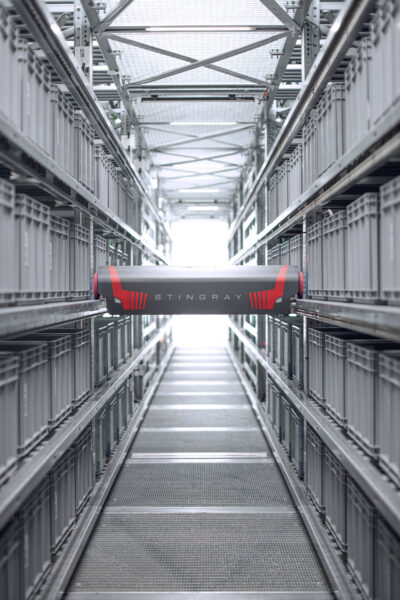-
Entire system performance increased by ten percent
-
Shuttles unite performance with reliability, a rugged design, and energy efficiency
-
Maximum availability: manual intervention is reduced by up to 90 percent
-
Focus on sustainability: use of wood saves 25 tons of plastic per year
The Stingray shuttle is the efficient all-rounder for transporting totes, cartons, trays, and hanging goods. More than 20,000 shuttles are in use worldwide and prove their reliability day after day. With this advanced shuttle generation, robustness and sustainability are the focus. Covers are now made of wood, a renewable raw material from local production sites, saving 25 tons of plastic per year.
As part of the FlashPick® goods-to-person system, shuttles play a central role in automated warehouses, along with other TGW solutions. They transport totes and cartons, as well as trays weighing up to 110 pounds. The Stingray HG (Hanging Garment) is a special variant designed for transporting goods on hangers, such as dresses, coats, or suits.
 The main strength of the Stingray is its high performance for order picking or order consolidation in any environment: normal/ambient, refrigerated, or freezer. Capacity-driven applications with lower performance requirements can also be covered efficiently by partial loading.
The main strength of the Stingray is its high performance for order picking or order consolidation in any environment: normal/ambient, refrigerated, or freezer. Capacity-driven applications with lower performance requirements can also be covered efficiently by partial loading.
Ten percent higher performance for the overall system
With a throughput of more than 1,500 load carriers per hour, the latest generation of shuttles is the most powerful shuttle in the world. Its performance is ten percent higher than its predecessor and it is twenty percent faster, with a top speed of over 16 feet per second.
75 percent less time and effort for maintenance
“The latest Stingray generation unites the highest performance and reliability with energy-saving operation and sustainable materials”, explains Thomas Gruber-Blanka, Director of Product Management at TGW. “Users benefit from an extremely short commissioning time thanks to the plug-and-play concept. Full data transparency also enables condition monitoring and predictive maintenance; both help to optimally schedule maintenance and increase availability.“
The shuttles also perform automatic “health checks” on their own, detect twisted totes, and resolve the situation without human intervention. All-in-all, manual interventions can be reduced by 90 percent and the maintenance effort by 75 percent.
Energy saving function as standard feature
Since shuttles accelerate and decelerate several hundred times per day, the potential for saving energy is especially high. Stingrays store braking energy in power capacitors and then make it available to all vehicles on the same level for acceleration. All shuttle and tote lifts are also equipped with an energy recuperation function as a standard feature, feeding unused energy back into the power network. In addition, the dynamic parameters can be adjusted flexibly, depending on the order situation.











